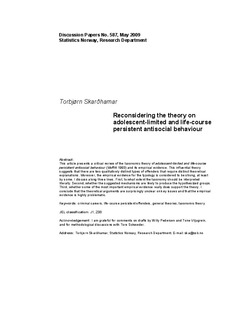| dc.contributor.author | Skarðhamar, Torbjørn | |
| dc.date.accessioned | 2010-11-22T12:48:52Z | |
| dc.date.available | 2010-11-22T12:48:52Z | |
| dc.date.issued | 2009 | |
| dc.identifier.issn | 0809-733X | |
| dc.identifier.uri | http://hdl.handle.net/11250/180027 | |
| dc.description.abstract | This article presents a critical review of the taxonomic theory of adolescent-limited and life-course persistent antisocial behaviour (Moffitt 1993) and its empirical evidence. This influential theory suggests that there are two qualitatively distinct types of offenders that require distinct theoretical explanations. Moreover, the empirical evidence for the typology is considered to be strong, at least by some. I discuss along three lines. First, to what extent the taxonomy should be interpreted literally. Second, whether the suggested mechanisms are likely to produce the hypothesized groups. Third, whether some of the most important empirical evidence really does support the theory. I conclude that the theoretical arguments are surprisingly unclear on key issues and that the empirical evidence is highly problematic. | en_US |
| dc.language.iso | eng | en_US |
| dc.publisher | Statistics Norway, Research Department | en_US |
| dc.relation.ispartofseries | Discussion Papers;587 | |
| dc.subject | Criminal careers | en_US |
| dc.subject | Life-course persistent offenders | en_US |
| dc.subject | General theories | en_US |
| dc.subject | Kriminalitet | en_US |
| dc.subject | Ungdom | en_US |
| dc.subject | Sosiologi | en_US |
| dc.subject | JEL classification: J1 | en_US |
| dc.subject | JEL classification: Z00 | en_US |
| dc.title | Reconsidering the theory on adolescent-limited and life-course persistent antisocial behaviour | en_US |
| dc.type | Working paper | en_US |
| dc.subject.nsi | VDP::Social science: 200::Sociology: 220 | en_US |
| dc.source.pagenumber | 21 | en_US |
